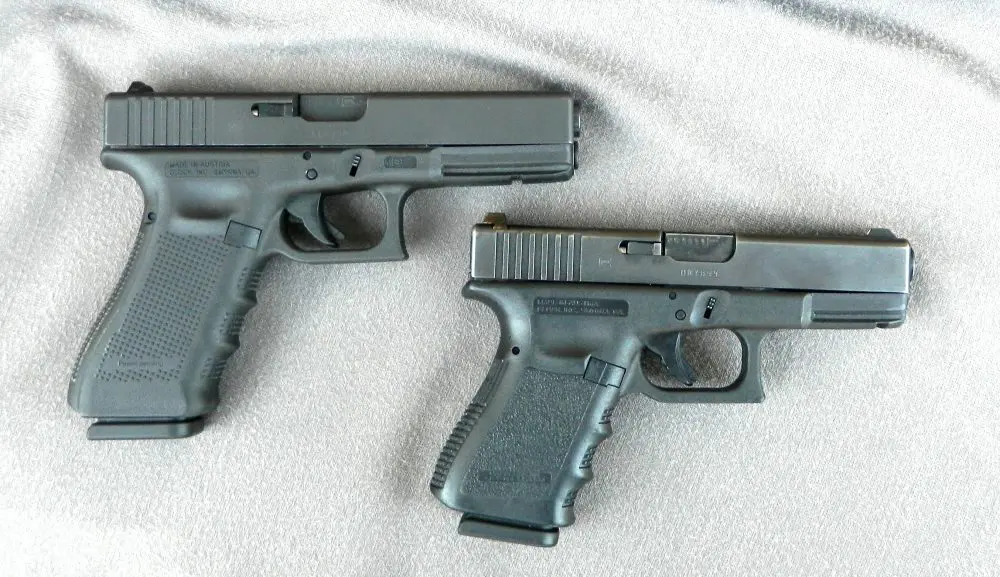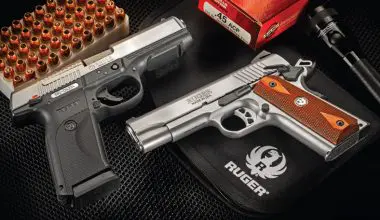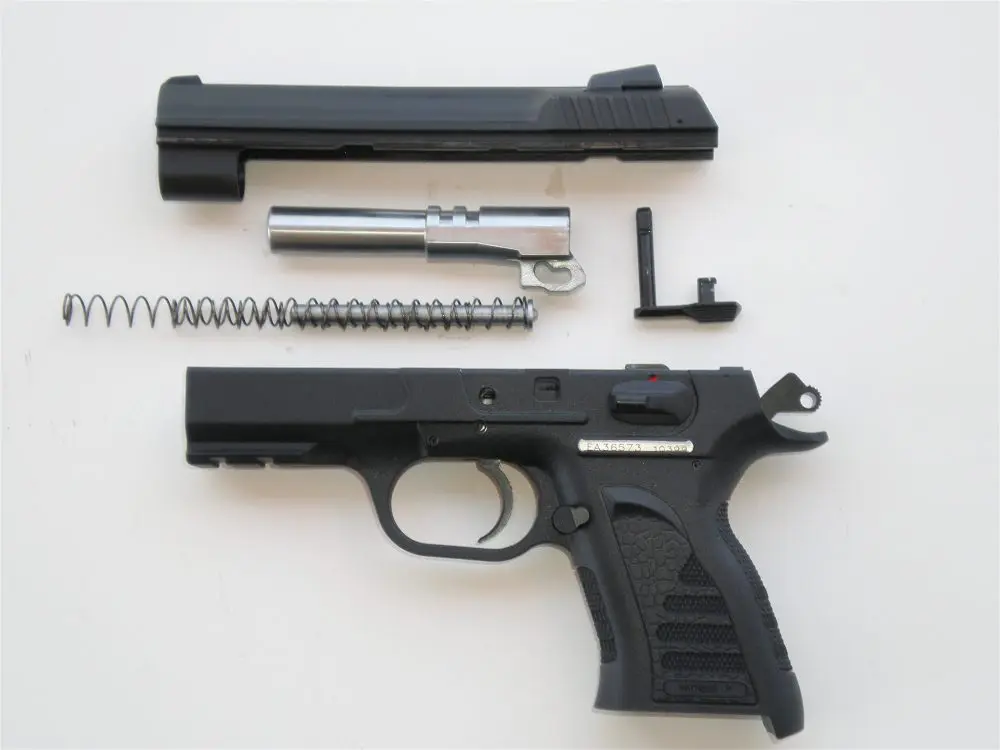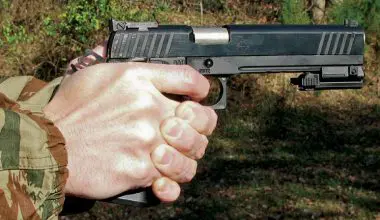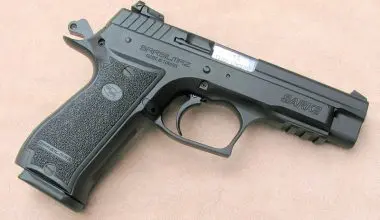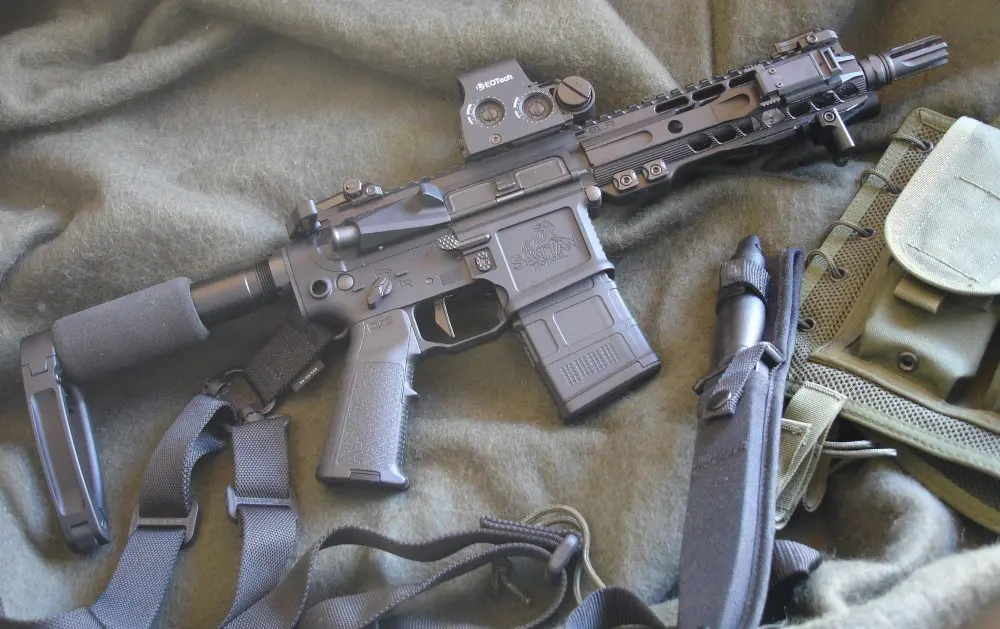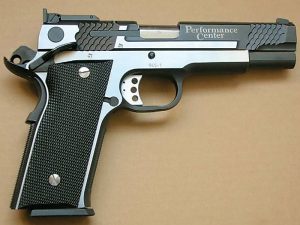
Shortly after I retired, I became an adjunct instructor at the Smith & Wesson Academy. Retired Massachusetts State Police Colonel Bob Hunt was the director and, even though his son, Bob Hunt Jr., was an FBI agent, colleague and member of the Bureau’s Hostage Rescue Team (HRT), I still had to audition for the job by attending one of the Academy’s classes, in which the boss also participated.
At that point he wanted to know if I could shoot. He took his son’s word for it that I could instruct. I think he was sufficiently impressed when the range lights were extinguished and we had to shoot a tight group completely in the dark.
A former Navy SEAL who worked for a facility that maintained military counter-terrorism assets’ weapons and conducted some R&D for the teams had built my 1911. The Kart Barrel 1911 did not fail me, and my blind group was celebrated with a wide grin from Colonel Hunt. The six-foot, four-inch, lean-and-mean former Marine loved to shoot too.
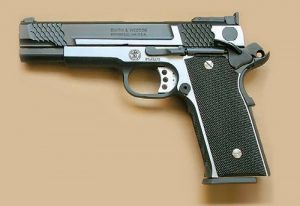
Table of Contents
MY TEACHING EXCALIBUR
Bob had the Performance Center build me a special five-inch double/single-action .40 S&W high-cap pistol that, while appreciated, I could not get comfortable with. I eventually gravitated to their Glock-like Sigma, liked its feel, and got pretty good with it.
I taught Close Quarters Battle Pistol, Raids One and Two. Bob brought a highly prized Generation One S&W 945 in .45 ACP to one of the classes. The Performance Center had completely blackened the gun and given it an additional trigger job. Trigger pull weight was 2.5 to 3.0 pounds, Author’s 945 field-stripped shows linkless barrel and 14-pound recoil spring with guide rod that has its own internal spring. Magazines are eight round. Stocks are wood laminate. Hex screws were later changed to slotted screws.which matched many of my competition handguns. Bob encouraged me to try it and if I liked it, it would be my teaching pistol.
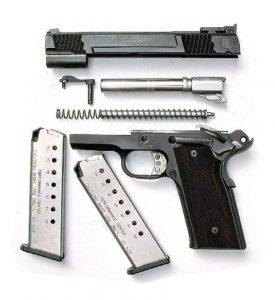
Liking it was an understatement. After letting all the students run a magazine through it, I claimed it for my own. From that point forward, it was my teaching Excalibur and was one of the finest factory .45s that I ever encountered. The pistol presented to me was all black and did not have the two-tone cosmetics that standard 945s featured. I did not receive its presentation case, but more importantly got additional eight-round magazines.
HISTORY OF THE 945
After presenting the public with a number of single-action pistols ranging from the M745 to the M845 with limited success, it became clear that the public wanted a heavy-caliber Smith with John Browning’s familiar features.
The Performance Center’s Dick Mochak was the 945’s designer. It is a hybrid, a combination of the 4006 series and their 1911 offerings. The
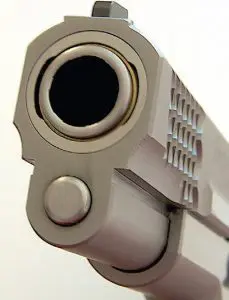
Generation Three 645 contributed the slide and the 4506 provided the base. By combining the single action and active safeties from the 1911 with the above platform, Smith and Wesson created a unique and desirable firearm that did not resemble their historic rival’s iconic piece.
Performance Center (PC) guns originate from standard designs or are created from scratch. From hand cutting and fitting to fine tuning for precision, these firearms are top performers. Products from the PC are the ultimate expression of old–world craftsmanship blended with modern technology.
Mochak did away with a number of undesirable 1911 features. The 945’s barrel is linkless. It uses a spherical barrel bushing and external extractor, and it acquired a superior grip angle. For me, the Smith and Wesson 945 points better than any 1911 I own and it fills the hand nicely.
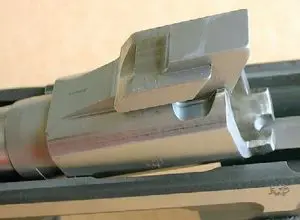
Unlike my high grip when shooting my 1911s, I have never had a problem depressing the 945’s Wilson grip safety. Some competitive shooters have a habitual problem with the 1911’s grip safety, particularly if they ride the safety S&W 945 shed rotating barrel link and opted for fixed lug. Barrel’s chamber is fully supported. Photo: Atlantic Tacticalwith the thumb. Many disable it or tape it down when competing.
ACCURACY OBSESSION
At the time, Smith and Wesson was obsessed with accuracy, and many of their higher-priced pistols featured Briley’s spherical barrel bushing. The 945, at 40.9 ounces with empty magazine and 49.6 ounces fully loaded with nine 230-grain freight trains aboard, was no exception and is a tack driver.
The pistol debuted in 1996 and was released in 1997. A limited number of four-inch compact and 3¼-inch Law Enforcement sub-compact versions became available later in its longevity. During its decade of existence, weights ranged from 43.5 ounces to current specifications of 40.5 ounces.
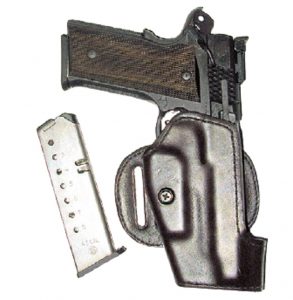
THE 945
My specific 945 is a substantial pistol, made of stainless steel throughout, save for the laminated and checkered wood grips that are held to my model by Hex screws. The 14.1-ounce slide’s dorsal surface is flat like a shotgun rib but without striations, and carries the dovetailed front sight blade and fully adjustable Bo-Mar target sight.
Its fore and aft flats feature attractive and efficient “Dragon scale” grasping cuts. The fully supported and ramped Performance Center barrel has no loaded chamber indicator. That came later. Rifling is 1:16, and the muzzle is crowned.
Reflecting its era, the 945 does not have a laser/light rail on the dust cover. The firing pin can be removed via a 1911-style firing pin stop. Its right side features a large and substantial extractor that claws spent cases through an enlarged and lowered ejection port. Exterior and interior finishes are smooth and error free.
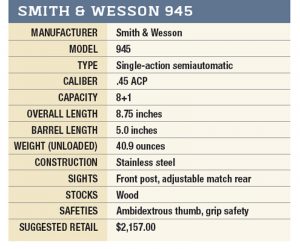
The slide’s interior reveals only one locking lug recess. Perhaps the 945’s most unique feature is the use of a spherical Briley bushing to provide consistent and tight barrel lockup at the muzzle. Briley is best known for its shotgun chokes, but makes myriad 1911 parts and components.
The receiver’s substantial hand lapped and polished rails provide full support to its slide. Ambidextrous thumb safeties are of the gas-pedal style and engage and disengage smoothly and positively. The ejector is spring-loaded and must be depressed to reassemble the pistol.
Looking like Thor’s war hammer, the “Match Hammer” is of the Commander style and slaps the firing pin with authority. It has a half cock stop. Cupping the hammer when at full cock is a raised beavertail grip safety. It guides the hand into a high grip and distributes recoil. It is intuitive to operate and unblocks the trigger when depressed.
The pistol’s backstrap is machine checkered at 30 LPI, and its front strap has the same treatment at 20 LPI. Although the cuts are even, there is top and bottom vertical overrun on the front strap, which detracts from the costly gun’s appearance.
The magazine well is beveled for easier magazine exchanges, and the standard-size trigger guard is undercut, permitting a higher grip. The left-side magazine release is slightly enlarged, and the magazines jettison with vigor. The thin grip panels are dark laminated wood held firmly in place by Hex screws. The slide stop is very 1911.
As received, the adjustable aluminum match trigger was set too light for law enforcement and personal defense, but competitive shooters would love it. It is smooth with no stacking and breaks crisply at 2.5 to 3.0 pounds. At the outset of my relationship with the 945, surprise breaks were commonplace.
As I became attuned to the trigger’s character, I could execute “now shots” or command detonations without premature discharges. At the time, Videki triggers were the preferred component for higher-end 1911s. I would think that Smith and Wesson would opt for this piece of precision for the 945.
EARLY MODELS CAUTION
As indicated, my model is an early iteration and has no loaded chamber indicator view port, which is located at the rear of the barrel hood’s 12 o’clock.
But more seriously, Smith and Wesson advises that 945s with no dash (-) in the model number should not be carried with a round in the chamber because it has no firing pin block. Models with the dash in the number have such a safety device. When I received the pistol, I was unaware of the absence of the above safety, and carried cocked and locked in all my classes without incident.
A lot is made of bore axis, and the holy grail of pistol design is to get the hand in line with the barrel to create straight-back recoil without cutting the hand. The Smith and Wesson 945’s bore axis is slightly higher than a 1911’s, but it was irrelevant for me when I was able to draw and rip off two-second Bill Drills from seven to ten yards. The pistol’s comparative recoil was soft and it reindexed the target on its own. Kinetic forces were well distributed.
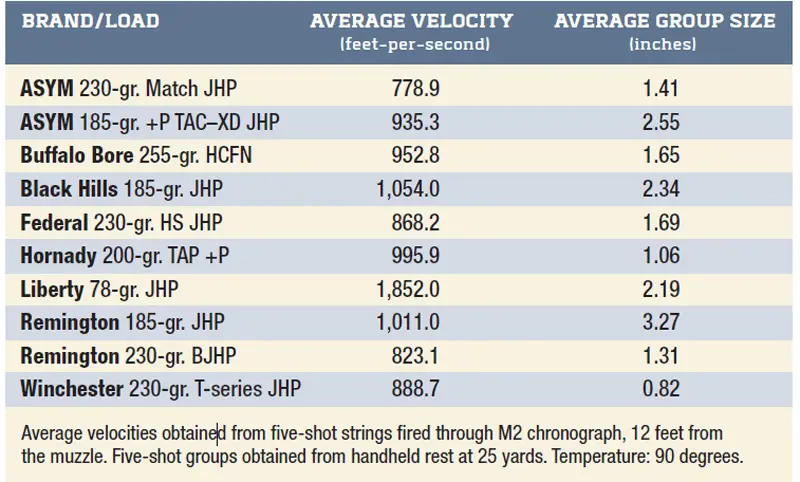
EATS EMPTY CASES
Reliability is so impressive that the pistol will cycle spent shell casings. Its reliability and soft recoil can be attributed to its relatively long lock time before the slide opens to eject the empty case. The 945 comes with two recoil springs. A 14-pound spring is installed for ball and duty ammunition, and a 12-pound spring is available for wadcutter and match loads. This is interesting, because standard weight recoil springs for the 1911 range from 16 to 18.5 pounds. Slide weight differences may be a factor.
The biggest problem I had with the piece was finding a holster for it. However, London Bridge’s nylon leg-drop rig worked out fine, as all my courses were considered tactical. I did not realize at the time that holsters made for the 4005 would probably have accommodated the piece.
RANGE TIME
The 945 is a fine pistol and deserved a superior shooter to exploit its accuracy. Top Shot: All Stars’ finalist William Bethards did the honors. William shoots for the Cabot Pistol team. Their entry-level 1911s start at over $3,000. ASYM 230-grain JHP ammunition is his match load, and William produced cold-bore 1.41-inch five-round groups from a handheld rest at 25 yards.
Winchester’s wonderful 230-grain T-series JHP (FBI HRT load) punched out an excellent 0.82-inch cluster. The ultra-lightweight Liberty CD 78-grain +P JHP sizzled across the sky screens at 1,852 feet-per-second (fps). If there was any lateral deviation to the group, it was determined that the culprit was a broken rear sight pin that caused it to list to port.
William expects perfection from his Cabot competition guns, and he felt that the sight’s angled mount had a slightly negative effect on overall accuracy.
What would have been a zero-defect run with 100% reliability was marred by the hammer falling to half cock during a rapid-fire string. The pistol may have been on its way to doubling, but William always vacates the trigger (does not use trigger reset) between shots and may have interrupted the cycle.
William considered the 945 a heavy and large pistol, with the grip’s horizontal length longer than his 1911’s. He liked the pistol’s looks and profile and it had a good trigger, albeit with a little too much overtravel.
Front-strap checkering is excellent—effective but not too aggressive. The slide’s scalloped serrations are functional, and William liked its extended slide stop. Recoil was manageable even with hot loads, and our speed-shooting drills were conducted with Federal 230-grain Hydra-Shok JHP exclusively. I shot this load in USPA/IPSC competition, because it was free from my employer. At 868 fps, power factor is 199. No wonder I never beat Leatham!
I have only one conclusion to offer: My Smith and Wesson 945 is a keeper.
